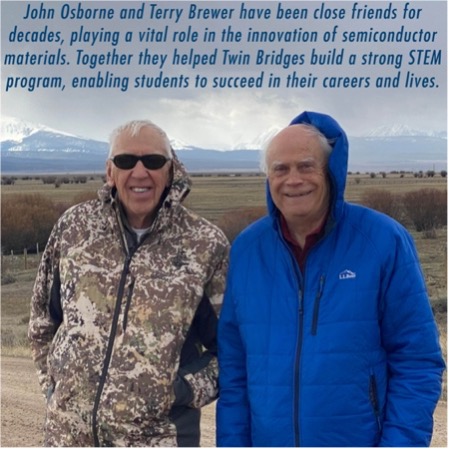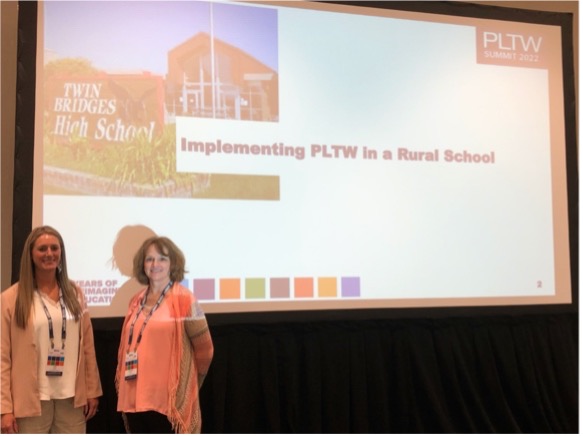How a small, rural school implemented a STEM curriculum with the help of Brewer Science
Nestled among the mountains of Montana lies the rural town of Twin Bridges; just barely over 400 people live in the small town. However, it taught our nation a big lesson – the importance a solid foundation in STEM education plays in students’ success.
A Surprising Discovery
John Osborne established a scholarship for graduating seniors in his hometown of Twin Bridges for those ranking top 10% in their class to attend college. In 2015, the valedictorian of Twin Bridges High School, an ambitious young girl, dreamed of pursuing a Biomedical Sciences degree at an east coast school. A semester into her freshmen year, she reached out to John and told him she could not keep up with the other students with stronger chemistry and science backgrounds. This led to the surprising discovery that offering a scholarship is not always enough to enable students to succeed. Building a strong foundation in STEM education is necessary for their careers.
Building a STEM Education Program
John Osborne and Terry Brewer have been close friends for decades, playing a vital role in the innovation of semiconductor materials. While they both frequently give professional lectures on manufacturing and leadership, neither has a teaching background. Brewer Science has actively supported STEM education in its local communities by collaborating with Project Lead the Way, a nonprofit organization that develops STEM curricula for K-12 educators. John created an outline based on Project Lead the Way’s curricula that enabled the superintendent to understand how the program would be implemented.
Starting in the Middle
The program started with 6th and 7th-grade students, because it is easiest to learn new concepts at that age. , Jen Elser, introduced the program by implementing a robotics program for her 6th-grade students and a medical detective program for her 7th-grade students, using Project Lead the Way kits.
As students transitioned from the typical textbook instructional method of education in 5th grade to the new, hands-on, STEM-focused teaching approach in 6th grade, they swiftly adapted. They appreciated the increased scope of soft skills the program promoted, such as teamwork, problem-solving, and communication.
Community Collaboration
The program also enabled collaboration with the community. For instance, the local hospital exposed the students to real-life examples in their medical detective program. Each week, a doctor volunteered to teach students different skills, such as checking heartrate. The students applied these skills to a dummy cadaver used in the medical detective program and gave a report to their class, promoting strong collaboration and communication skills.
Enthusiasm for Education Soars
In the second year of the STEM education program, the students were excited to participate in a Robotics Competition. The superintendent was cautious about the school’s participation and the expansion of the STEM program. However, after seeing the classroom, he said it was the most enthusiasm he has ever seen in a school in over 16 years of being an educator. Twin Bridges took 4th place in the state level of the robotics competition and then placed 8th in the tri-state class.
The students were not the only ones excited about the STEM education program. Teachers would meet at the library on Saturday evenings, plan their curriculums and determine the program’s next steps. Teachers from other grade levels were interested in expanding elements to their classrooms.
Expanding the STEM Education Program
Also in the 2nd year of the program, 5th-grade students started a program focused on engineering, manufacturing, and renewable energy. Over a few years, more grade levels started the STEM-focused educational programs, expanding to 1st grade.
An ambitious kindergarten teacher wanted to ensure her students were ready for the hands-on STEM education they would receive in 1st grade. Traci Tilstra took it upon herself to research the methodology and received a donation of iPads, so students could make movies and show them to their families. The students’ communication skills improved significantly. She expanded the STEM program to include beginning lessons on how to code.
Challenges Implementing the STEM Education Program
Funding
The expansion of educational options required funding and resources. When Terry Brewer heard of the fantastic things his friend John Osborne was achieving at Twin Bridges Schools, he offered a $50,000 grant to help cover the expansion of the programs. For example, the 6th-grade students learning about medical detectives could also choose additional curriculum options focused on microchips and technology. This helped more students get involved in the program and sparked the curiosity of more students’ interests.
Parents
When high school students came home talking about optical sensors in robots and middle school students discussed careers in the medical field, the conversations went over the heads of the parents, and this frustrated some families. Twin Bridges invited parents and community members to dinner with a presentation explaining the new program and how it benefits students. The first year this dinner was hosted, 70 out of the 74 families who attended found the dinner presentation beneficial.
Remote
The hands-on approach to STEM education requires classroom participation so it was challenging to accommodate the remote learning experience most schools were using during the pandemic.
A Promising Outlook for Students and Their Futures
In 2022, two teachers from Twin Bridges attended the National PLTW Conference to share the school’s journey. 
The program was praised because it gave students a strong outlook on careers. Several parents enrolled their students from nearby school districts. One of the students was a child of a single-parent household.
“There was a 7th-grade student who came up to me after a lecture from one of the local doctors. She said she thought she would be a waitress at one of the local restaurants because that’s what her mother did,” states John Osborne. “However, after hearing about doctors and their professions, she changed her goals to become a surgeon. The program is opening students’ eyes to opportunities they did not know existed before.”
Learn more about Project Lead the Way on their website. Subscribe to the Brewer Science blog for updates on how we are enabling the next generation of innovators and encouraging a STEM-focused education in our communities.

